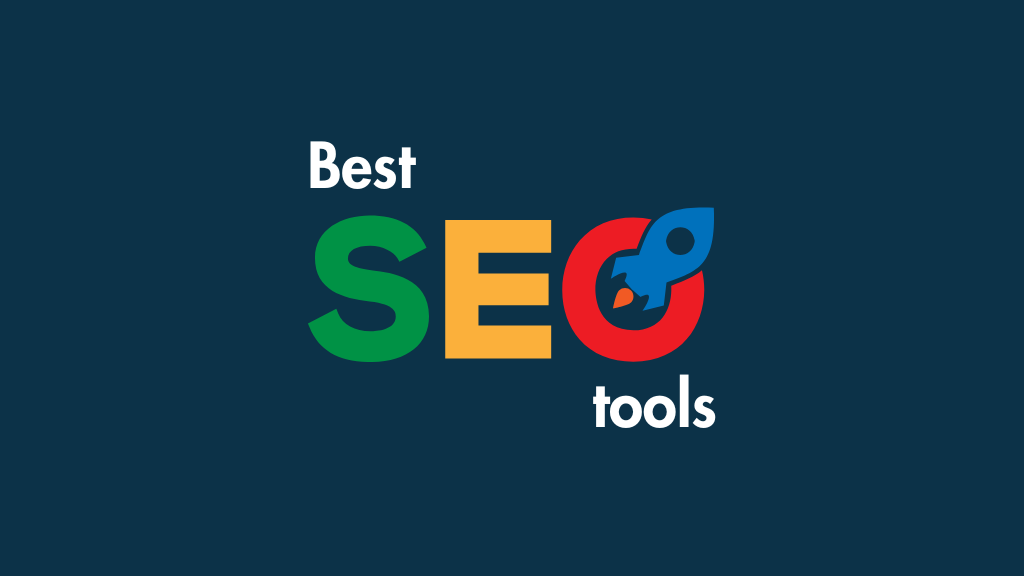
There’s no shortage of SEO tools out there…but how do you decide between them? Well, in this post, I’m going to run you through ten key ones that you really should consider — and help you work out which one is right for you.
ℹ️ Please note: This isn’t a ‘ranked’ list — I have simply included the SEO platforms that based on my tests I believe are genuinely worth exploring in 2025. My aim is to match you with the best tools for your individual needs.
And if you’re unfamiliar with any of the terms that crop up in my best SEO tool roundup, feel free to dip into our SEO glossary for a quick explanation of all terms used in the article.
Best SEO Tools — quick links
Google Search Console
Google Search Console (GSC) is free, quick to set up, and helps you understand how Google sees — and interacts — with your website.
Once you verify your site with GSC, it lets you
- access data on the search queries that bring people to your site’s pages
- see how your content is performing in Google search results
- identify quick SEO wins or content that might need improvement.
Significantly — and unlike third-party search engine optimization tools that rely on best guesses and traffic estimates — GSC gives you data directly from Google.
(This makes the tool essential, even if you’re using other SEO platforms alongside it.)
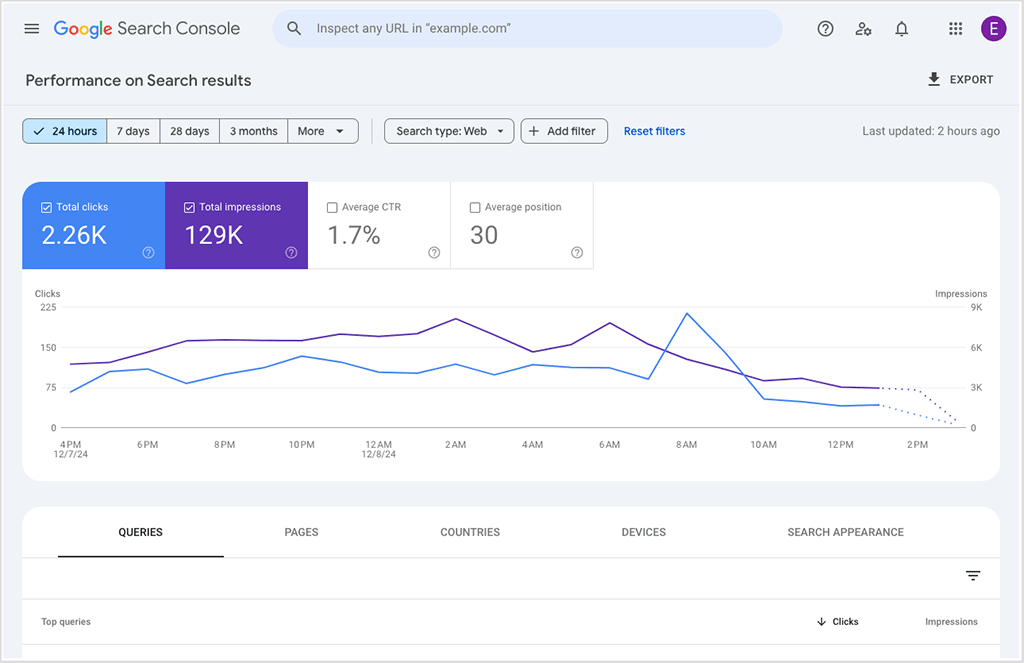
GSC is also very useful for spotting technical issues. If it finds problems with crawling, page indexing, mobile usability or page speed on your site, it flags these clearly and helps you fix them.
You can also use the tool to submit a sitemap (or individual web pages) to Google’s index — this helps its algorithms understand your site’s structure, or get content into the search engine results faster.
When it comes to backlink tracking, Google Search Console gives you a simple but helpful overview of which sites link to your content and which of your pages attract the most inbound links. While it doesn’t give you as much data as a dedicated link analysis tool, it’s still a good (and free!) starting point for understanding your site’s link profile.
Another useful GSC feature is its ‘Core Web Vitals’ reporting. Core Web Vitals (CWV) metrics relate to how users experience your site — measuring things like loading speed, visual stability and how quickly people can interact with your content. Google takes all of this data into account when ranking pages, so understanding how your site is performing from a CWV perspective is really important.
Finally it’s worth noting that many of the other tools covered in this article — including Semrush, SE Ranking, Moz and Ahrefs — allow (and encourage) you to connect your Google Search Console account to their systems. Doing so enhances these platforms’ functionality and gives you a more complete picture of your SEO performance.
Who is Google Search Console best for?
Google Search Console is important to anyone managing a website — especially beginners who want trustworthy data and clear SEO guidance. Even if you’ve involved paid-for tools in your SEO workflow, Google Search Console remains one of the most important tools to check regularly.
👉 You can access Google Search Console here.
SE Ranking
SE Ranking is a fully-featured SEO platform that delivers a lot more than you’d expect at its price point — so it’s one that I often recommend to freelancers and agencies who don’t have enterprise budgets, but are still aiming to run serious SEO campaigns.
It covers all the essentials: rank tracking, SEO audits, backlink analysis, keyword research and competitor monitoring — all within a clean, beginner-friendly interface. It also gives you a built-in SEO marketing plan tool that walks you through the site optimization process, step by step.
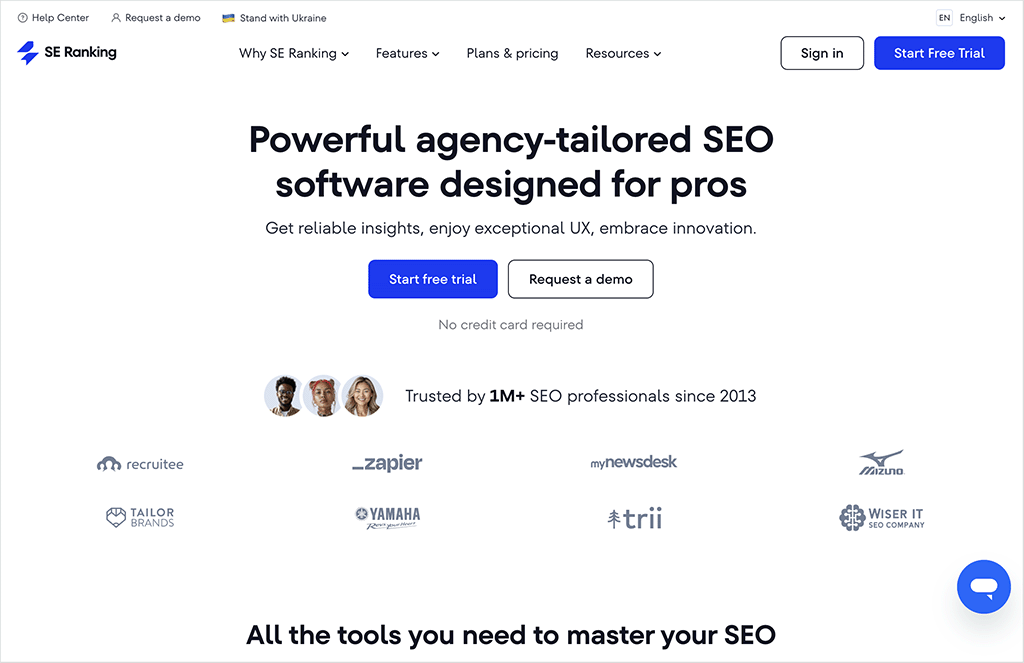
SE Ranking’s rank tracker is particularly good. The company claims this tool is 100% accurate, and in my experience that holds up. I’ve tested it extensively across different locations and devices, and the results have consistently aligned with real Google rankings. You can also use the tool to view SERP features like snippets and star ratings, with daily updates on search positions provided.
Keyword allowances in SE Ranking are generous too. The entry-level plan lets you track 500 keywords; the mid-tier ‘Pro’ plan lets you track 2,000; and the ‘Business’ plan lets you track 15,000, which is extremely generous compared to the limits you’ll find on similarly priced plans from competing SEO tools.
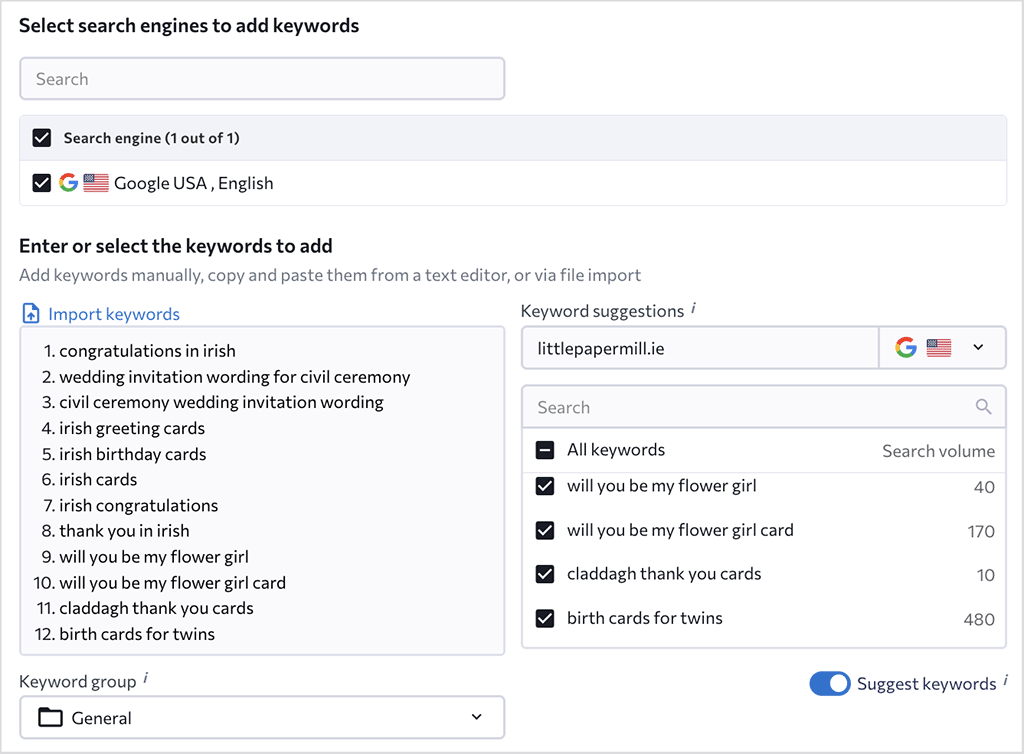
In terms of overall database size, SE Ranking is a solid mid-to-upper-tier performer. It gives you access to:
- over 5.6 billion keywords across 190 countries
- a backlink database of 2.9 trillion links
- 2.2 billion domain profiles.
These numbers don’t quite match what’s available from Semrush or Ahrefs, but they’re more than adequate for most SEO campaigns.
One of the areas where SE Ranking really stands out involves the number of websites you can track with it. For example its mid-tier offering, the ‘Pro Plan,’ lets you track 30 sites — 10 more than Ahrefs’ ‘Standard’ plan and 15 more than Semrush’s ‘Guru’ plan.
(Given that SE Ranking is considerably cheaper than both Ahrefs and Semrush, these more generous limits represent considerable value for money.)
And if you need even more flexibility, SE Ranking’s ‘Business’ plan removes the cap entirely and offers unlimited project slots — something neither Ahrefs or Semrush provide on their non-enterprise plans.

SE Ranking is also more generous than most big-name SEO platforms when it comes to user access. Its ‘Pro’ plan provides three seats and its ‘Business’ plan five — key competing tools typically limit you to just one seat, irrespective of plan, and charge significant amounts of money to add more users.
But with SE Ranking, each extra seat costs just $20 per month — making it one of the most affordable tools to scale across a growing team.
SE Ranking is also a very viable option for agencies. Its ‘Agency Pack’ is available on annual ‘Pro’ or ‘Businesses’ plans for an extra $50 per month. This unlocks:
- a white-label interface and reporting
- client access seats — 10 on Pro, 100 on Business
- unlimited scheduled SEO reports
- a lead generation widget for your website.
That means you can deliver professional reporting to clients under your own branding, without needing to move onto an expensive custom-tier subscription.
Who is SE Ranking best for?
SE Ranking is a great fit for SEO freelancers, consultants and agencies that work across multiple websites. It suits users who need high project limits, affordable user access and reliable reporting tools. It may not quite offer the data scale or advanced outreach features found in high-end SEO suites, but for hands-on SEO work, I think it’s one of the most flexible and cost-effective platforms available.
👉 You can learn more about SE Ranking here.
Moz
Moz has been a significant player in the SEO world for over two decades, and unlike many of the biggest SEO tools — which now aim to be all-in-one-marketing platforms — it still focuses on giving you easy-to-use, practical SEO tools. With pricing starting at just $49 per month, it’s also one of the more affordable platforms around.
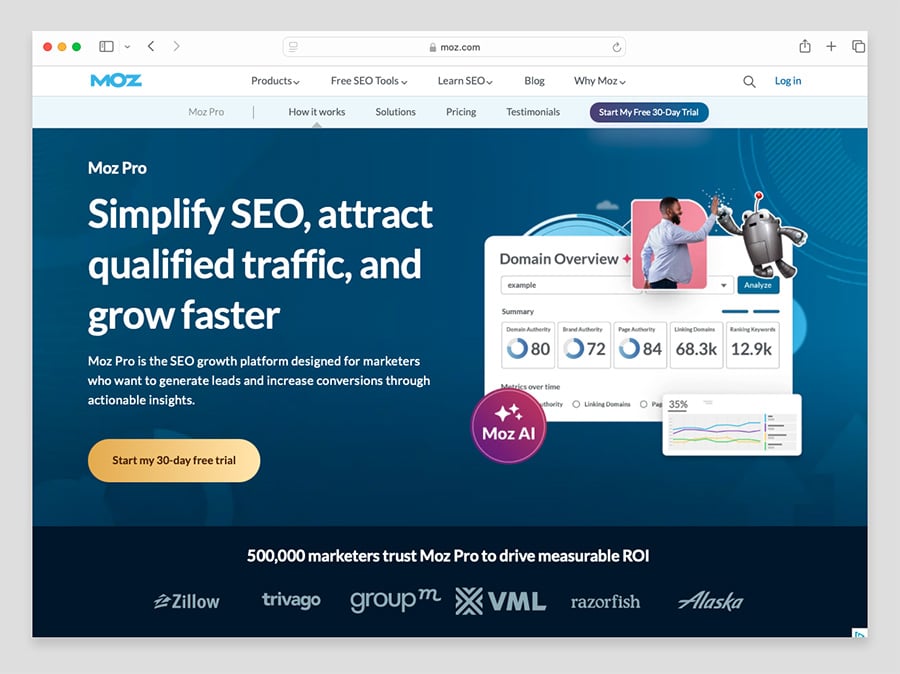
One of Moz’s most distinctive features is its ‘brand authority’ score. This metric provides a rating between 1 and 100 that reflects how well-known a site (or its parent company) is — something that’s becoming increasingly important these days, thanks to Google’s increasing obsession with brand awareness as a ‘trust’ signal.
Using this feature, you can see how your brand score compares to key competitors, with a helpful matrix that plots brand and domain authority side by side.
I also really like Moz’s ‘domain search theme’ summary, which identifies a site’s core topic based on search behavior. This is a helpful reference point, especially for content-heavy or multi-topic sites. It’s useful for checking if your site’s topical focus is clear — and for quickly assessing whether another domain is a good fit for link building outreach.
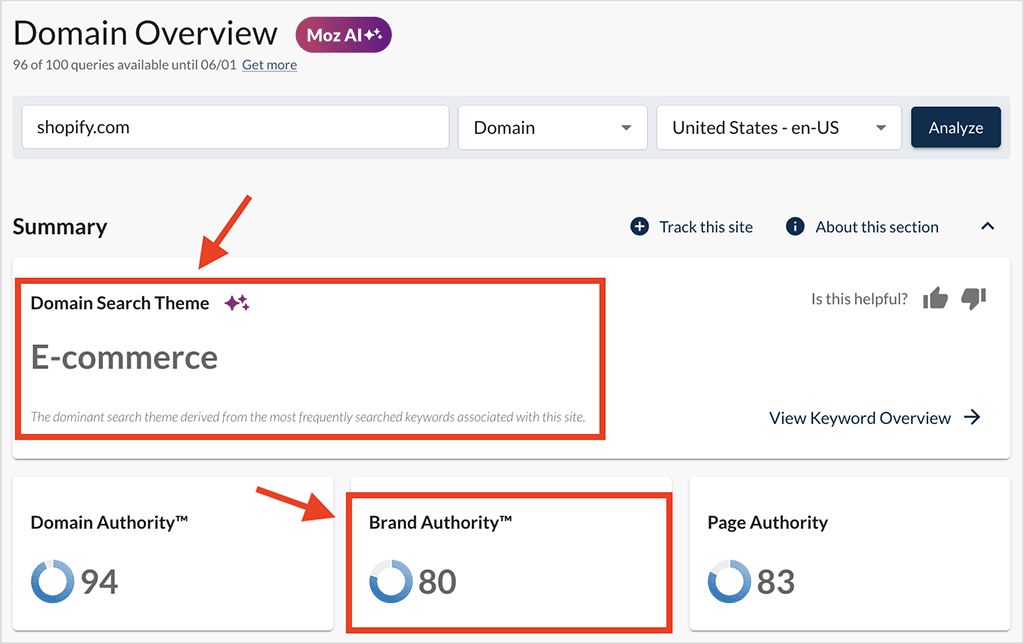
Moz’s backlink index is larger than most — it currently contains over 44.8 trillion links — and contains essential data on referring domains, anchor text and link freshness.
Site auditing is another area where Moz performs well. Its site auditor gives you two key tools — a crawler that identifies technical issues with your site, and an on-page grader that assesses the quality of your content. The reports that these tools output flag things like crawl errors, missing metadata, broken links and keyword stuffing.
(You also get an ‘on-demand’ audit from Moz that lets you perform one-off audits on websites. These are more basic in nature, but don’t eat into your campaign limits.)
Moz’s crawl limits are generous too. On its $99 per month Standard plan, you can audit up to 400,000 pages per month — far more than you’ll get from most similarly priced tools. And the limits stay high as you move up the pricing tiers.
Moz also offers affordable API access, which is very rare among leading SEO platforms. If you want to bring Moz’s SEO data into your own dashboards or applications, you can do so from just $5 per month. Most competing tools lock API use behind very expensive custom pricing or enterprise tiers.
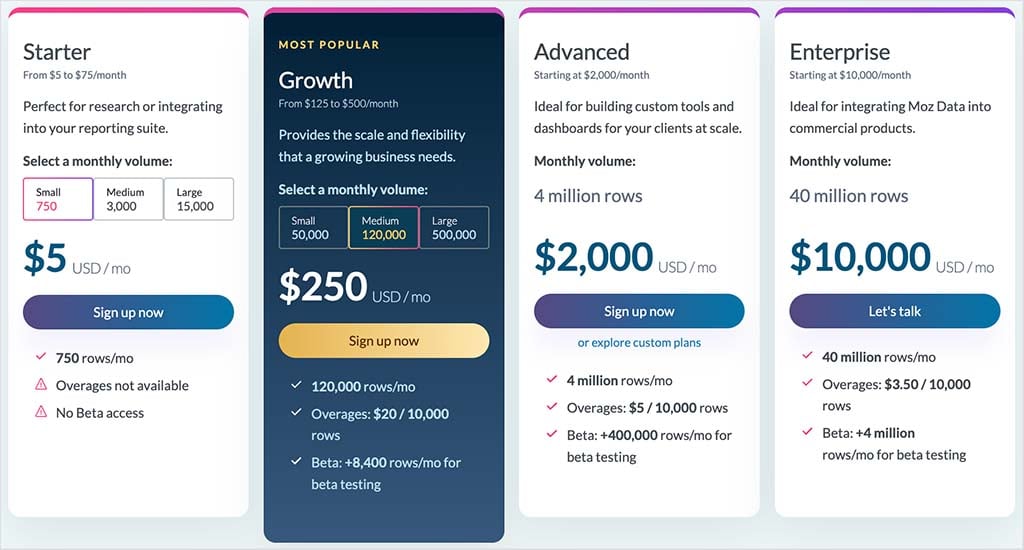
A key Moz drawback is its lack of traffic estimates for competing domains, however. For me, this considerably limits its usefulness for competitor research. (However, if you connect your Google Search Console account to Moz, you can access your site’s traffic data from within the platform.)
And, perhaps most significantly, its keyword database size is relatively small — it contains just 1.25 billion keywords, a lot less than those of key rivals Ahrefs, SE Ranking and Semrush. This means that Moz is not the best tool for getting keyword suggestions.
And despite its very large backlink database, Moz doesn’t give you access to any linkbuilding outreach tools. Some competing platforms — Semrush being a prime example — give you a lot of built-in features for doing this.
Who is Moz best for?
Moz won’t suit every type of workflow. It doesn’t have the outreach tools or traffic analysis features you’ll find in more expensive tools. But it’s priced keenly and extremely useful if you need site auditing, link data and API access — or if you’re building a brand and want to track how well it’s taking hold online.
Ubersuggest
Ubersuggest is a budget-friendly SEO tool that handles the essentials in a simple, beginner-friendly package. It doesn’t aim to rival the depth of platforms like Semrush or Ahrefs — but with a starting price of $29 per month (frequently discounted to just $10), it gives you one of the cheapest ways to access usable SEO data.
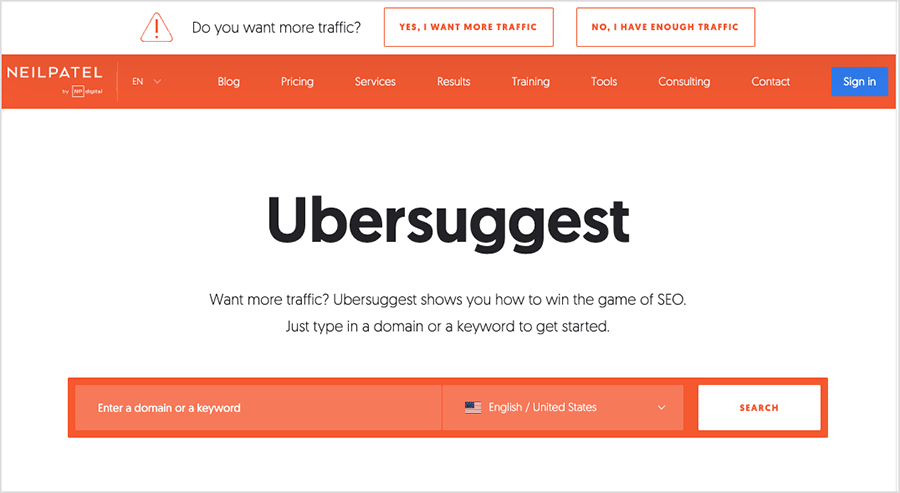
Despite its low price tag, Ubersuggest gives you many of the core features you’d expect: keyword suggestions, backlink analysis, domain reports, site audits and rank tracking. These are lighter-weight versions of what you’ll find in more advanced tools, but they’re functional enough for simpler SEO projects. And, thanks to its very intuitive interface, Ubersuggest is a particularly good option if you’re just getting started with SEO.
In use, I’ve found Ubersuggest’s ‘Top Pages’ report particularly handy. This gives you a quick snapshot of a site’s best-performing content, including traffic estimates, backlinks — and even social share data from Facebook, Reddit and Pinterest. You’ll sometimes need to pay extra for top pages reports when using competing products, so it’s a nice inclusion.
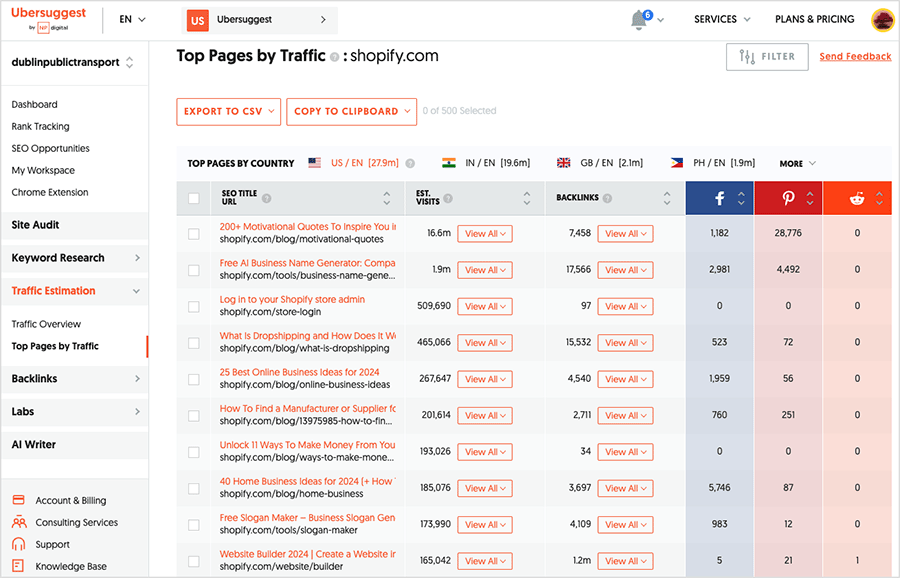
Ubersuggest also deserves praise for its mobile usability. Its interface is fully responsive, letting you run audits, check rankings, or do keyword research directly from a phone or tablet — something surprisingly few SEO tools do well.
Another bonus is its Chrome extension, which surfaces key metrics like search volume, domain authority and backlink counts right inside live search results. It’s a convenient way to keep key data visible while you browse.
For support, Ubersuggest includes access to biweekly coaching and live Q&A calls with Neil Patel and his team.
Ubersuggest isn’t the best option when it comes to keyword research however, because it uses Moz’s keyword database. As I discussed earlier, this is quite small and limits the number of keyword suggestions you can get in ways that other tools don’t.
Ultimately, Ubersuggest isn’t built for deep competitive research or large-scale tracking — but if you need a simple, easy-to-use toolkit that covers the basics and won’t drain your budget, it’s a decent entry-level choice.
Who is Ubersuggest best for?
Ubersuggest is best for solopreneurs, bloggers and small business owners who want essential SEO tools, helpful coaching, and the flexibility to work on mobile — all without committing to an expensive monthly fee.
Semrush
Semrush is one of the biggest names in SEO — and also one of the most fully-featured platforms on the market. While its wide range of features may be a lot to take in for small-scale users, the quality and feature-richness of its tools are unquestionably good.
Let’s start with keyword research. Semrush’s keyword database is enormous — second only to Ahrefs’ in size — and gives you access to 26.6 billion search terms used in more than 120 countries. You can filter by search intent, keyword difficulty, SERP features and keyword type (i.e., question-based searches, branded terms etc.).
There are also dedicated Semrush tools for researching keywords on Amazon, YouTube, Google and Bing’s search engines; live CPC data for paid search campaigns is also available within the platform.
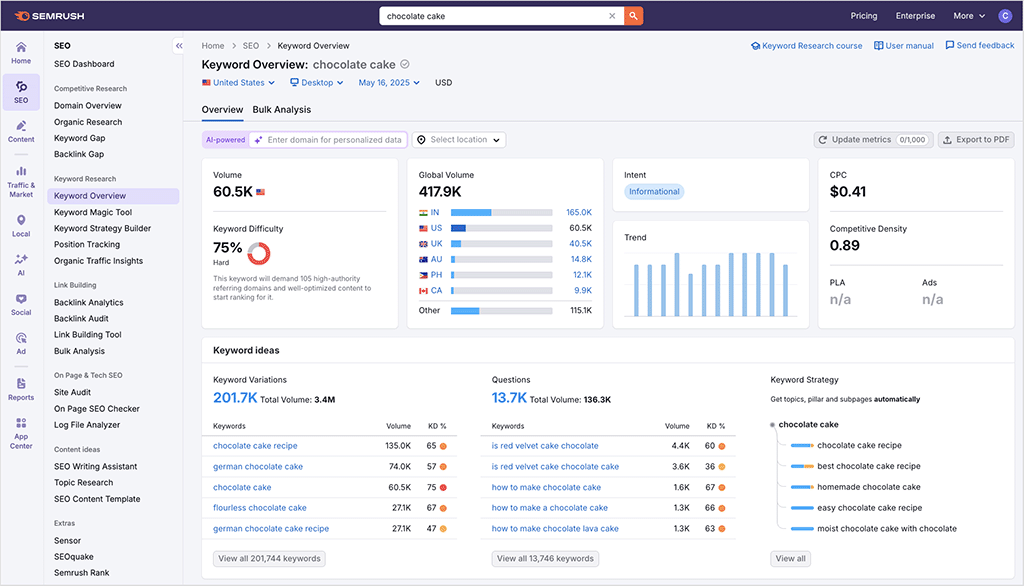
One of my favorite Semrush features — and one exclusive to the platform — is its personalized keyword difficulty score. While most tools give you a generic keyword difficulty rating based on overall competition for it, Semrush goes one further by estimating how hard it would be for your site to rank for a given term.
It does this by taking your topical authority, backlink profile and content performance into account to give you a far more realistic picture of what’s achievable for your specific site. For me, this is one of the smartest features in the platform — and one I find myself returning to regularly when prioritising which keywords to target next.
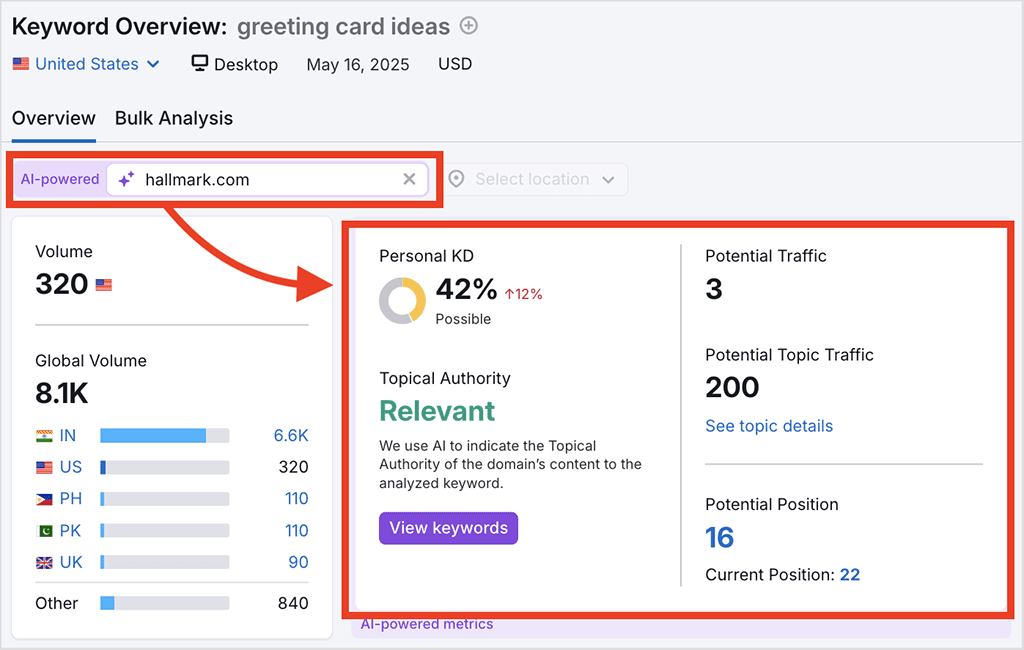
On the rank tracking side, Semrush lets you monitor your keyword positions daily across Google and Bing, as well as in emerging tools like Google’s AI Overviews and ChatGPT Search.
You’ll also find very comprehensive pay-per-click (PPC) data available within the platform. Semrush gives you access to ad copy previews, historical spend and positioning data, CPC figures, and tools to help you build out keyword lists and plan Google Shopping campaigns. In terms of SEO and PPC integration, it’s definitely one of the strongest platforms on the market.
Semrush’s backlink database contains over 43 trillion links and is among the biggest available — it’s larger than Ahrefs’ (35+ trillion links) and second only in size to Moz’s (44.8 trillion links). You can use this database to audit backlinks, monitor referring domains, check link profile toxicity and uncover gaps between your link profile and that of your competitors.
On the technical SEO auditing side, the platform performs well too. Semrush checks for over 140 technical SEO issues, including performance against Core Web Vitals, crawlability, duplicate content and HTTPS implementation. It also gives you a really handy on-page SEO checker that generates specific optimization ideas for individual URLs based on your target keywords.
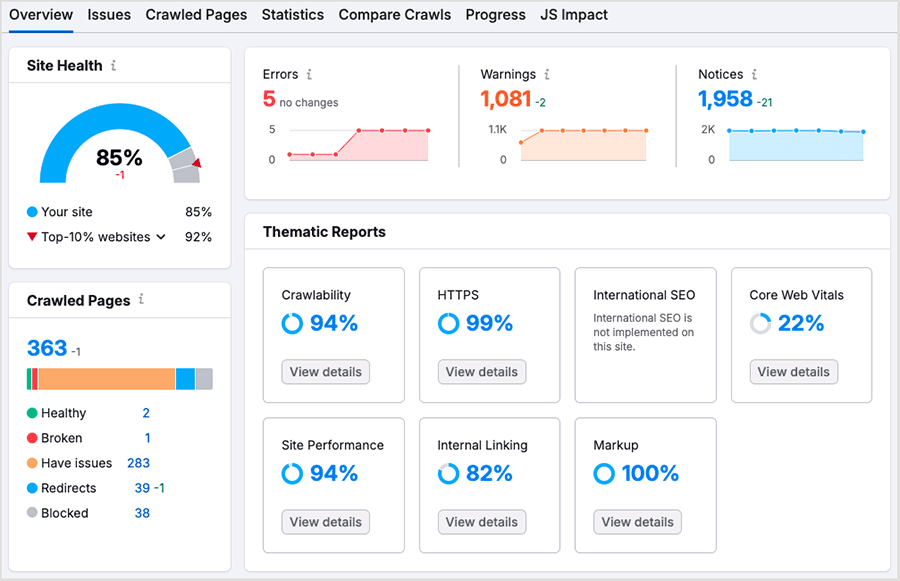
Semrush deserves real credit for its user experience. The platform packs in a huge number of tools, but the layout stays clean and consistent. It’s a powerful platform that manages not to feel overwhelming.
A big part of the reason for that boils down to how it handles data visualisation. Semrush’s reports on keyword trends, backlink growth and competitor performance are presented through interactive charts, sortable tables and easy-to-use filters; these all let you switch views, export visuals, and click into data points for extra detail. It’s one of the best tools I’ve used for turning complex SEO data into something you can actually act on.
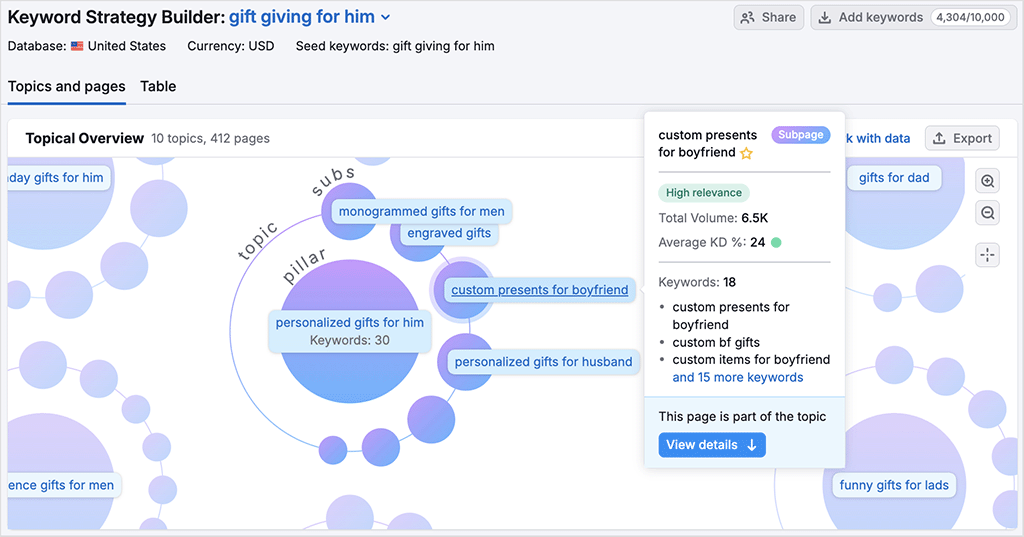
For content marketing, Semrush includes a dedicated suite of content tools on its ‘Guru’ plan and above. These help with topic discovery, SEO brief creation, content audits, and performance tracking. I particularly like its built-in SEO Writing Assistant, which scores your copy for tone, originality, and structure (and integrates neatly with both Google Docs and WordPress).
As someone who keeps a close eye on SEO platforms, I’ve noticed that Semrush tends to be first out of the gate when it comes to adapting to new trends. It was one of the first platforms to provide search intent data, and the first to integrate tracking for Google’s AI Overviews.
Beyond its core toolset, Semrush is also one of the most ‘extensible’ SEO platforms. There are two main ways to expand its functionality. First, you can use the Semrush App Center, which gives you access to a wide mix of specialist tools — these cater for a large range of use cases, including advanced content optimization, competitor benchmarking and local SEO.
All these apps integrate smoothly with the main Semrush interface, making it easy to extend the platform in ways that suit your specific workflow.
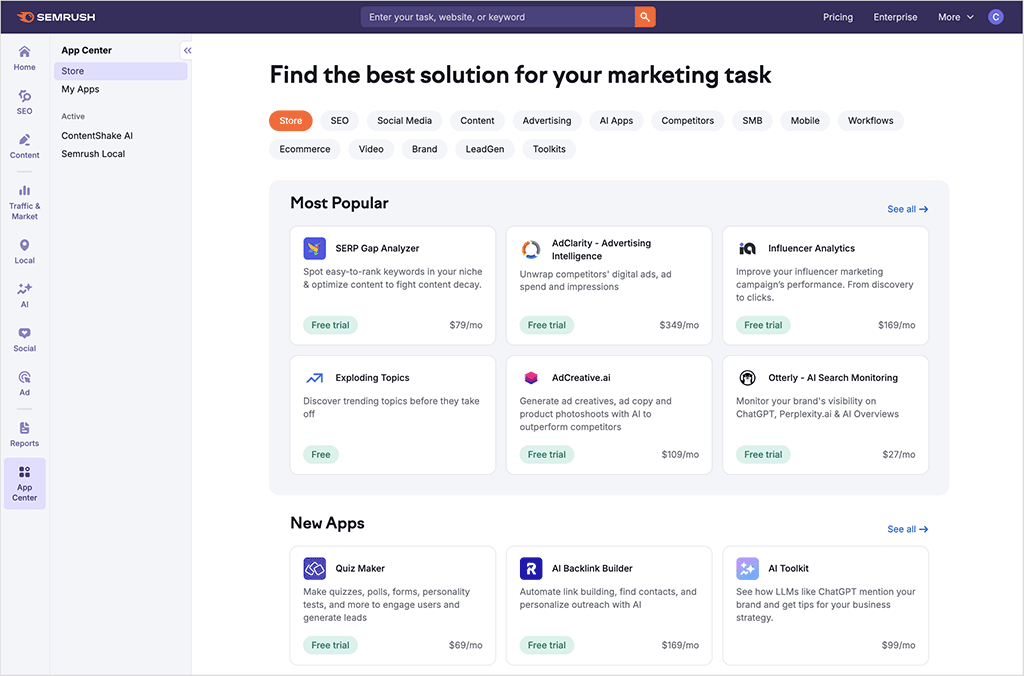
You can also buy official Semrush add-ons that extend the platform into broader areas of marketing. These include:
- Traffic & Market add-on – for monitoring web traffic trends, competitor activity and regional market insights.
- Social SEO add-on – AI-powered tools for social media management, including content generation, post scheduling, competitor tracking and platform-specific analytics.
- Content add-on — AI-powered tools for topic research, brief creation, unlimited article generation and SEO-focused content optimisation.
- Local SEO add-on – tools for managing Google Business Profiles, local listings, reviews and map rankings.
- Advertising add-on – tools for ad creation, keyword research and competitor ad analysis.
- AI add-on – for tracking brand visibility across AI chatbots like ChatGPT, Gemini and Perplexity.
The entry-level Semrush plan comes in at $139.95 per month. That’s pricier than options like SE Ranking or Moz, and roughly on a par with Ahrefs — but then again, Semrush isn’t just an SEO tool. It’s a full digital marketing platform, with tools for keyword research, technical audits, PPC data, content creation and competitor intelligence all bundled into one. If you need all of that in one place, it earns its price tag.
Who is Semrush best for?
For access to the most complete set of digital marketing tools in one place, Semrush is hard to beat. It’s not just an SEO platform — it’s a full marketing suite that covers everything from keyword tracking and backlink analysis to provision of PPC data, content creation tools and competitor intelligence information. If you’re managing SEO alongside paid campaigns or technical audits, it’s one of the most capable and well-rounded platforms available. The pricing reflects its range — but for teams that need breadth and depth, it’s a smart investment.
Yoast
The Yoast plugin is one of the most widely used SEO tools in the world — with over 13 million users — and it’s a go-to tool for anyone running a WordPress site. It’s not a keyword or competitor research platform; instead, Yoast focuses squarely on ‘on-page’ SEO, helping you optimize individual posts and pages as you write.
The plugin gives you real-time guidance on everything from keyword placement to heading use to readability, making it particularly useful for bloggers, publishers and businesses that produce content regularly.

Its core features include:
- Content analysis (keyword usage, headings, meta descriptions)
- Readability checks (sentence length, passive voice, transition words)
- URL and slug optimization
- Internal linking suggestions
- Schema markup for rich results
- Canonical tags to avoid duplicate content.
The core WordPress plugin costs $99 per year, and there’s a Shopify version available too for $19 per month.
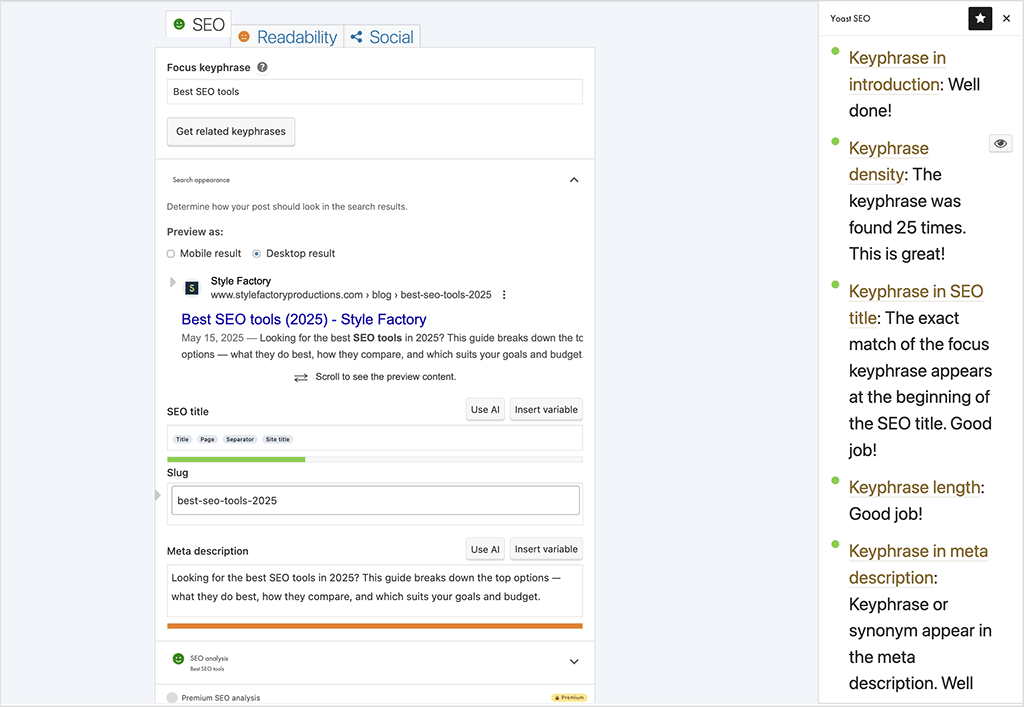
Yoast also offers several add-on tools for WordPress, each priced at $79 per year:
- Yoast News – this optimizes articles for inclusion in Google News.
- Yoast Video – this helps your videos appear in search results, via rich data and schema.
- Yoast Local – this adds structured data to aid visibility in local search.
- Yoast WooCommerce – this fine-tunes product pages and metadata for better performance in search engines.
These add-ons help tailor your SEO setup to suit specific content types or business needs.
Who is Yoast best for?
Yoast is ideal for publishers and content-driven businesses who want to optimize posts and pages as they create them. It’s great for improving readability, metadata, and on-page structure — all from within the WordPress or Shopify dashboards — and is especially useful for anyone running a blog, magazine or company news section.
👉 You can learn more about Yoast here.
Ahrefs
Ahrefs is one of the most established names in search engine optimization — and for good reason. It combines deep keyword research with excellent site auditing tools and a robust link analysis engine.
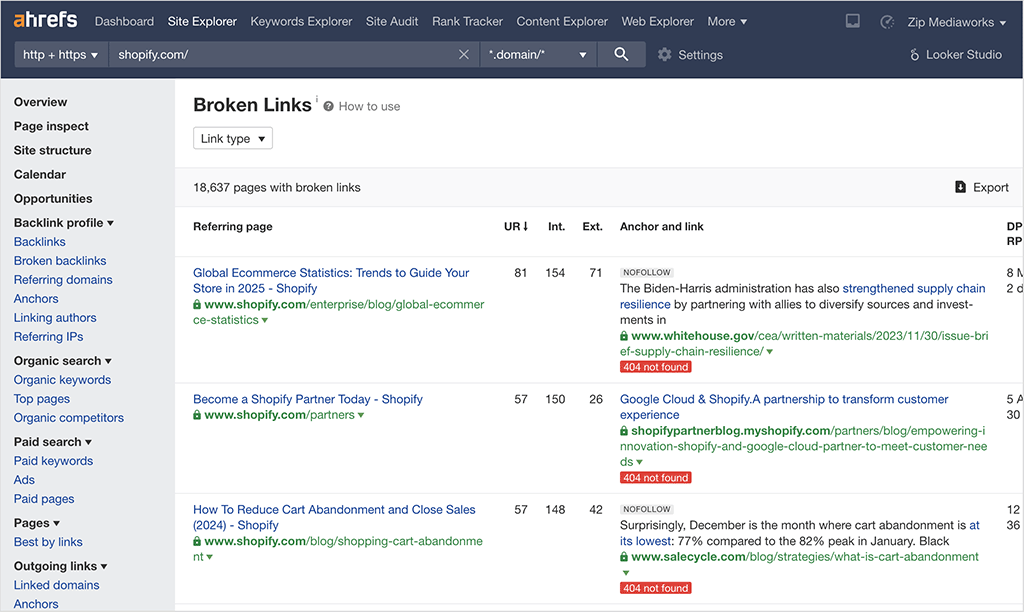
Project management in Ahrefs is more flexible than what you’ll find in most competing platforms. Depending on your plan, the platform lets track 5, 20, or 50 domains — making Ahrefs slightly more generous than Semrush (which lets you work with 5, 15 or 40), and significantly more generous than Moz (which lets you keep tabs on 1, 3, 10, or 25 websites). SE Ranking beats Ahrefs here however, facilitating unlimited projects on its higher-tier plans.
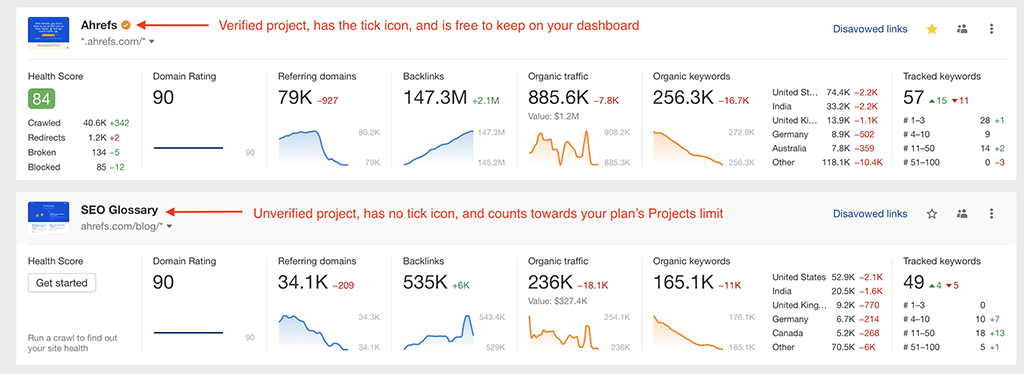
But Ahrefs’ website tracking story doesn’t end there — it actually gives you a way to work with an unlimited number of domains. If you can prove ownership of a domain (via DNS, HTML file upload or Google Search Console verification), Ahrefs lets you add it as a project outside your formal project allowance.
This means that even on Ahrefs’ $129 per month plan, you can manage an unlimited number of domains, so long as they’re verified. For consultants or agencies, this amounts to a scalable and cost-efficient setup — and one that will make Ahrefs especially appealing.
Ahrefs also boasts the largest keyword database of any major SEO platform. At time of writing (May 2025), it contains more than 28 billion keywords, spread across multiple countries and languages.
The data you can access using Ahrefs is comprehensive — amongst many other metrics, the platform lets you see keyword search intent data; the word count of top-ranking content; and estimates of how many external links it would take for your site to compete for a given keyword. But one of my favorite Ahrefs features is its ‘traffic potential’ metric, which lets you see the true potential of a keyword if you ranked number one for it (i.e., not just that keyword’s search volume). This is especially helpful for surfacing high-value keywords that don’t necessarily look impressive based on search volume alone.
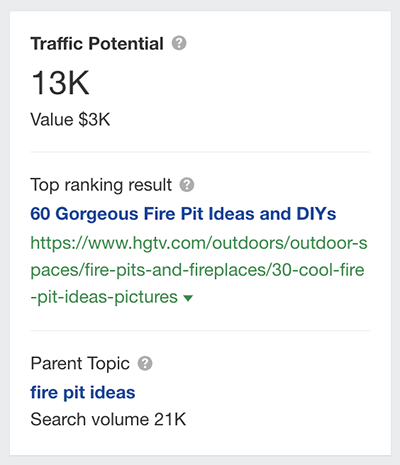
When it comes to data access, Ahrefs is generous — but only if you’re on a higher-tier plan. The $249 per month ‘Standard’ plan unlocks unlimited reporting and full tool access. Below that, the ‘Lite’ plan is far more limited — it gives you access to just 500 reports per month and more limited provision of keyword and link data in general.
Rank tracking is available on all Ahrefs plans and includes town-level targeting, which is useful for local SEO. You can monitor hundreds of keywords — even on the entry-level plan — but unless you pay for the pricey daily update add-on (currently $200 per month per project), rank positions only refresh weekly. That’s fine for some users, but not ideal if you need near real-time data.
Link data has long been a standout area for Ahrefs. While its backlink database is slightly smaller than Semrush or Moz’s, the way it presents link information is often better. The platform makes it particularly easy to filter link data by referring domains, anchor text, link type or platform, and finding broken links — whether internal and external — takes seconds.
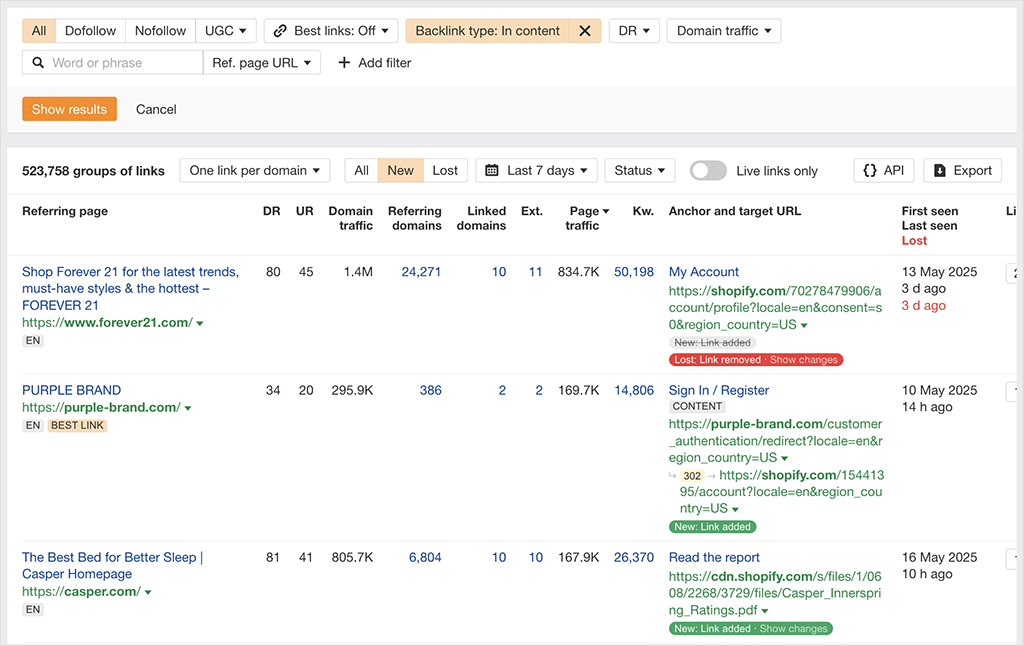
Site audits are another Ahrefs strong point. It gives you clean, clearly-prioritized lists of technical SEO problems along with performance suggestions; you also get full access to comprehensive Core Web Vitals data (including both field and lab metrics) in a single view. The audit interface is fast and well-structured, and lets you jump easily between error categories and problem pages without too much clicking around the place.
Ahrefs also offers some AI-powered content tools, available through its $99 per month ‘Content Kit’ add-on. These include a writing assistant, grading tools, and — in some plans — features for improving meta titles and descriptions. These tools are helpful, though not as fully developed as what you’ll find available from Semrush.
Weirdly, there’s no free trial for Ahrefs — this feels like a missed opportunity, especially given the platform’s relatively high price tag. Some free tools are available from the platform, but these are very limited in nature.
But ultimately, Ahrefs deliver high-quality, actionable SEO data — and lots of it.
Who is Ahrefs best for?
Ahrefs is an excellent option for marketers handling SEO for multiple sites. Its domain verification system makes multi-site workflows cost-effective; its keyword tools are powerful; and its interface makes Ahrefs one of the easiest SEO tools to use. While its pricing — and lack of a trial — won’t suit everyone, Ahrefs is unquestionably one of the most capable and data-rich SEO tools available.
👉 You can read our full Ahrefs review here.
Don’t miss out on our free SEO toolkit
For a limited time only we’re offering our readers some excellent free SEO tools and resources. Sign up now to immediately receive:
- our downloadable cheatsheet containing the 20 key steps to ranking highly in search results
- extended free trials and discounts for leading SEO tools
- our downloadable cheatsheet on how to grow organic traffic to a blog
- 2 in-depth guides to SEO
- ongoing free tips and advice on SEO and growing your business
SpyFu
SpyFu is a niche SEO tool with a really strong focus on providing PPC data — and if you run a lot of Google Ads campaigns, a potentially great fit for you.
The platform lets you see exactly what keywords your competitors are bidding on, how much they’re spending, and what kind of ad copy they’re using. It also gives you access to a whopping 19 years of historical PPC data, making it easy to spot long-term patterns and opportunities in your industry.
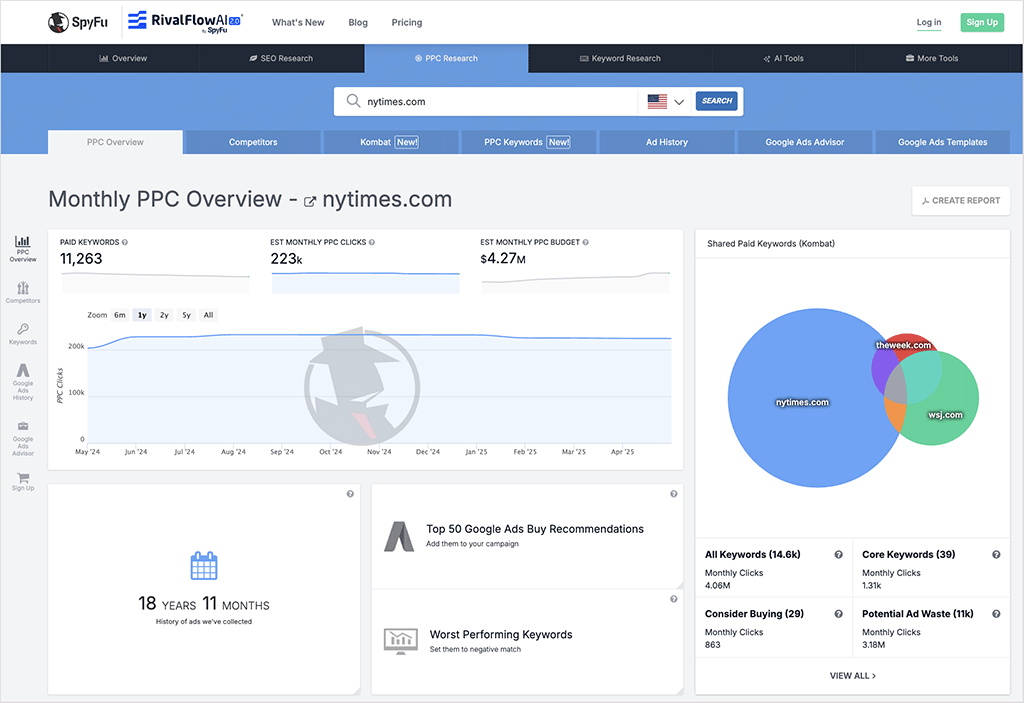
But SypFu is not just for PPC: you can also use it to perform keyword research, track rankings (up to 15,000 keywords on the Professional plan), and get basic domain-level SEO insights like organic keyword performance and backlink profiles.
For me, one of SpyFu’s standout features is its ‘Google Ads Templates’ tool. This lets you generate downloadable, ready-to-import campaign files based on your niche. These come complete with ad group structures, keyword recommendations, suggested bids, and example ads — and can be easily imported into Google Ads. In short, they give you a great way to jump-start a PPC campaign or expand an existing one without starting from scratch.
Unlike many of the tools on this list, SpyFu doesn’t aim to be an all-in-one SEO platform — it lacks site auditing, broken link detection and deep backlink analysis tools. But that’s by design: its focus is on delivering fast, valuable insights for search marketing, particularly in the PPC space.
Who is SpyFu best for?
SpyFu is best suited to advertisers, solo marketers and small agencies focused on pay-per-click campaigns. If your primary goal is to improve Google Ads performance through competitor insights and keyword discovery, it is a very useful piece of kit.
👉 You can learn more about SpyFu here.
Similarweb
Similarweb is a powerful digital intelligence platform that also includes a growing suite of SEO tools. While it’s not the obvious choice for every SEO user — especially novices or those on a budget — it offers something few platforms can match: a vast, multi-industry dataset covering web, app, ecommerce and even stock performance.
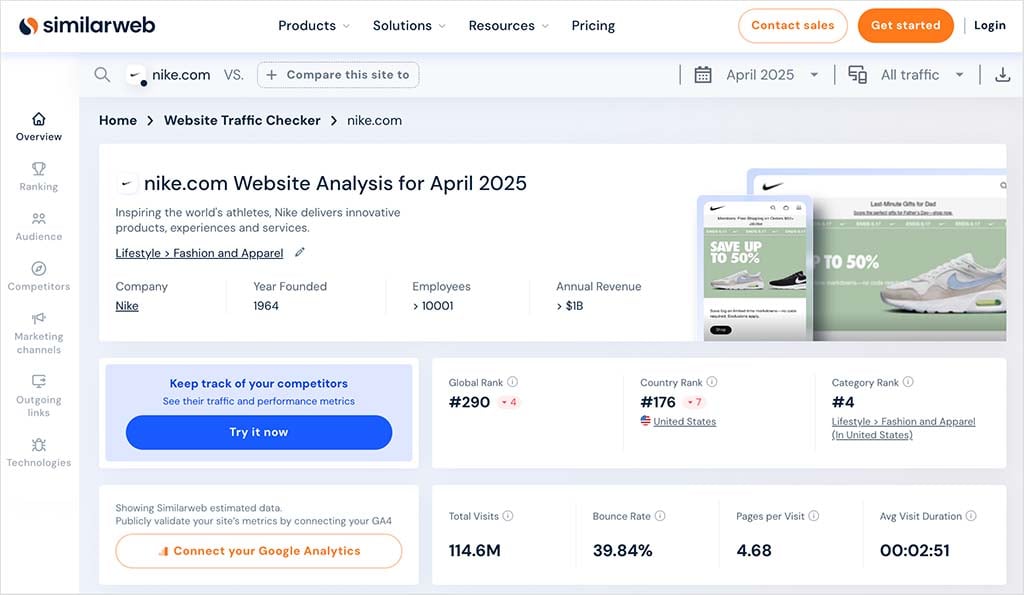
Similarweb’s database includes information around 5 billion keywords, 1 million websites and 40,000 mobile apps. On top of that, the platform offers digital insights into 3,000 stock signals, tracks the online activity of 20 million companies, and lets you monitor the performance of over 235 million ecommerce product SKUs.
It also provides detailed information about the technologies running on 200 million websites and 8+ million apps — making it a valuable tool for competitor analysis and broader market research.
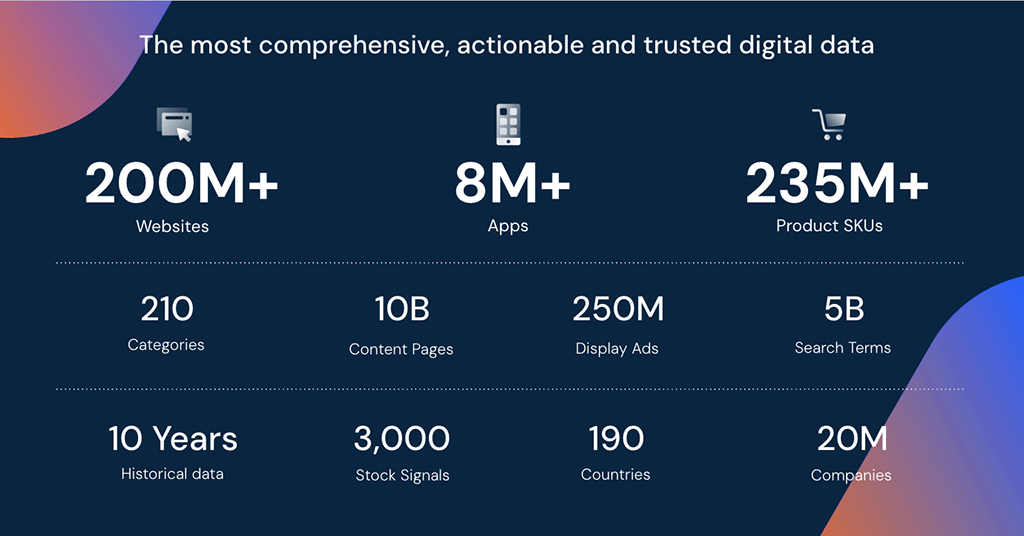
On the search engine optimization front, the platform supports keyword research, offers traffic and engagement metrics and highlights audience crossover between domains. It also gives you keyword suggestions for use on non-Google platforms (like Amazon and YouTube), along with interesting metrics like as zero-click search volumes. The platform’s site audit tool (available on enterprise plans) looks at over 300 technical SEO factors — far more than most competing tools.
Similarweb’s pricing, however, is something to watch out for. The only self-serve Similarweb SEO plan costs $199 per month and lacks several SEO basics like backlink data, rank tracking and site audits. To unlock these, you’ll need a Similarweb ‘Team’ plan or higher — and these start at a very hefty $14,000 per year.
Who is Similarweb best for?
Similarweb is best suited to SEO professionals who also need access to wider digital intelligence — whether that involves data on market trends, app performance, stock-related digital activity or ecommerce. For pure SEO work, other tools offer much better value. But for big budget businesses that want to combine SEO research with broader strategic planning, Similarweb arguably provides one of the most expansive datasets on the market.
👉 You can read our full Similarweb review here.
ChatGPT
ChatGPT hardly needs an introduction. As the fastest-growing AI tool — and arguably the most talked-about app of all time — it has completely transformed how people work with text. While it wasn’t built specifically for search engine optimization purposes, it has quickly become a powerful part of many content creation and SEO workflows.
ChatGPT can be used by SEO professionals in all sorts of helpful ways. It lets you:
- generate topic ideas based on keywords, trends, or audience interests
- create content outlines for blog posts, service pages, or product guides
- write or expand articles using a tone and structure that suits your brand
- simplify or rephrase content to improve readability and flow
- draft meta titles and descriptions tailored to specific pages or SERPs
- brainstorm keyword variations or supporting terms (especially with a bit of prompt guidance)
- write structured data (schema markup) for rich results, like FAQs or product pages
- create internal linking suggestions based on your URLs and topic structure.
It can also summarize text on complex topics, rewrite existing content to suit different audiences, and even help with brainstorming outreach email templates or blog headlines.
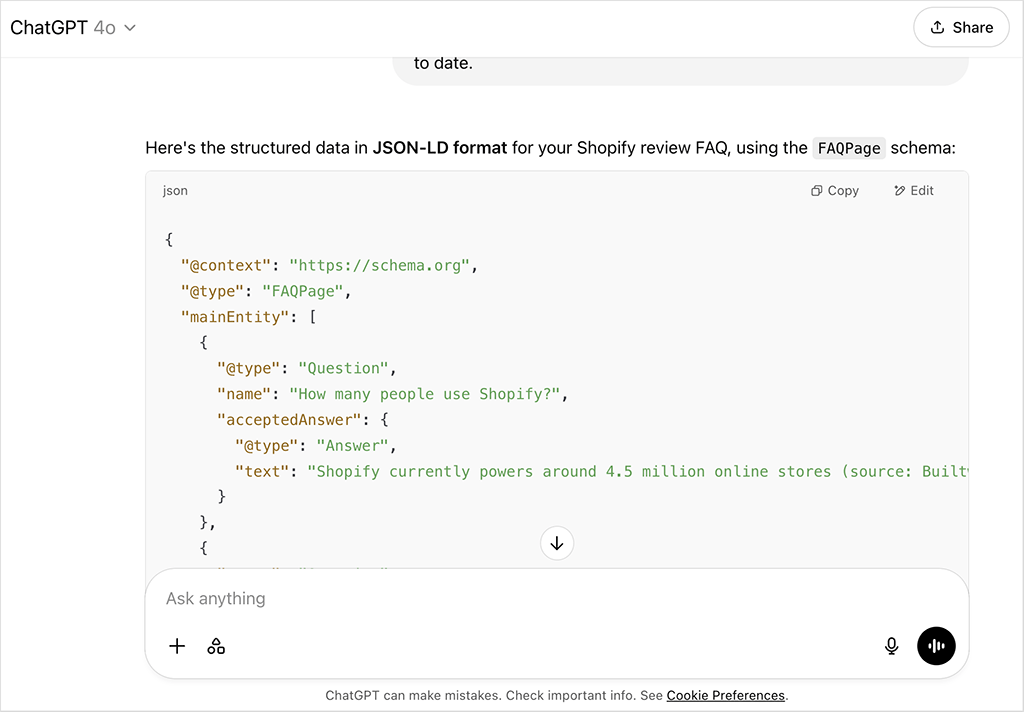
Out of the box, ChatGPT doesn’t give you real-time search data, or let you track keyword rankings — but when used alongside most of the other tools in this article, it becomes a flexible and powerful SEO writing partner. The free version is capable enough for most day-to-day SEO tasks, but the ‘Plus’ plan ($20 per month) offers better structure, more consistent tone control and improved handling of longer-form SEO content.
Who is ChatGPT best for?
ChatGPT is a great fit for content creators and SEO writers who want help with drafting, rewriting or idea generation. Its lack of an SEO database means that it won’t replace a dedicated SEO platform any time soon, but it pairs extremely well with one — and makes many parts of the SEO content process faster and easier.
👉 You can learn more about ChatGPT here.
(It’s also worth noting that ChatGPT now acts as a kind of search engine — especially when its browsing features are enabled. Alongside tools like Google’s new AI Overviews, this marks a growing shift in how users discover information online. As a result, content creators and SEOs increasingly need to think about Answer Engine Optimization (AEO) — structuring content in a way that makes it more likely to be cited by AI tools. Some SEO tools, including Semrush, are starting to support this via features that help track and improve content visibility in AI-generated answers.)
I hope you’ve found my roundup of the best SEO tools in 2025 useful — and that it helps you choose the right platform for your projects!
If you’d like to dive deeper, you’ll find plenty more of our comprehensive SEO tool reviews and comparisons here. I should also mention that our dedicated SEO hub is packed with loads of practical SEO tips and how-to guides.
Finally, if you have any thoughts or comments on any of the SEO tools mentioned above, feel free to leave a comment below — we read all of them and will do our best to help. 🙂
Comments (2)
A lot of redundancy with Moz, SE Rankings, SEMRush, and Ahrefs. Yoast is questionable, as there are far better SEO plugins for WordPress without the bloat and constant self-promotion from Yoast. And a glaring omission by leaving off Screaming Frog SEO Spider, arguably the most valuable SEO tool to have.
Thanks for your feedback John — agree that Screaming Frog is a great tool. We will probably be adding it in a future update of this post.